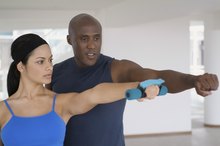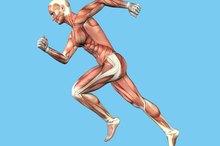Physiological Adaptations to Exercise
Humans have survived on this planet for thousands of years because of our ability to adapt. Physiological adaptations start to occur almost immediately when beginning a new exercise program. Many changes occur throughout the body, but the most significant changes include changes in the muscles, bones and cardiovascular system.
Neuromuscular Adaptations
The neuromuscular system is one of the first systems of the body to respond and adapt to a new training stimulus. These changes are a result of the motor units in the spine becoming for responsive at stimulating the muscle fibers. Previously inactive motor units become more active and work at a faster rate. As a result, you'll experience increased strength and power. Untrained individuals can experience substantial strength gains of 25 percent or more within three to six months, notes Jack H. Wilmore and David L. Costill, authors of “Physiology of Sport and Exercise.”
- The neuromuscular system is one of the first systems of the body to respond and adapt to a new training stimulus.
Muscle Growth
What Happens to Your Vessels When You Exercise?
Learn More
Muscle hypertrophy or muscle growth occurs as a result of long-term resistance training. Hypertrophy is changes in both the size and number of muscle fibers. Amino acids found in protein food sources enter the cells to build muscle when the training stimulus is significant enough to require additional muscles tissue. The rate of amino acid transport into the muscles is directly influenced by the intensity and duration of the muscle tension. Conversely, when normally active muscles become inactive or immobilized, muscle atrophy or muscle loss can occur, because the additional muscle tissue is no longer needed.
- Muscle hypertrophy or muscle growth occurs as a result of long-term resistance training.
- Amino acids found in protein food sources enter the cells to build muscle when the training stimulus is significant enough to require additional muscles tissue.
Bone Adaptations
Like muscle tissue, bones also respond to exercise stimulus. The bones become stressed during exercise when the tendons and muscles pull on the bone. This added strain on the bones stimulates the bones to become denser. The minimal essential strain is the minimum about of stress to the bone necessary for bone growth to begin. The minimal essential strain is thought to be 1/10 of the force need to fracture a bone, according to BrainMac Sports Coach. Regular weight-bearing exercise such as strength-training, walking and jogging is directly related to bone growth. However, inactivity can result in a decrease in bone density, which can lead to osteoporosis.
- Like muscle tissue, bones also respond to exercise stimulus.
- The bones become stressed during exercise when the tendons and muscles pull on the bone.
Cardiovascular Adaptations
Four Ways to Take Care of the Muscular System
Learn More
The cardiovascular system goes through many adaptations as a result of both aerobic and anaerobic exercise. The heart becomes more efficient at pumping and delivering fresh blood to the muscle tissues. Blood volume increases, new capillaries form to deliver more blood to the trained muscle, there are larger openings of existing capillaries and blood distribution becomes more efficient. As a result, resting and submaximal heart rates decrease, as well as your blood pressure, in response to regular aerobic endurance training.
- The cardiovascular system goes through many adaptations as a result of both aerobic and anaerobic exercise.
- The heart becomes more efficient at pumping and delivering fresh blood to the muscle tissues.
Related Articles
References
- West DW, Burd NA, Staples AW, Phillips SM. Human exercise-mediated skeletal muscle hypertrophy is an intrinsic process. Int J Biochem Cell Biol. 2010;42(9):1371-5. doi:10.1016/j.biocel.2010.05.012
- Cè E, Longo S, Limonta E, Coratella G, Rampichini S, Esposito F. Peripheral fatigue: New mechanistic insights from recent technologies. Eur J Appl Physiol. 2020;120(1):17-39. doi:10.1007/s00421-019-04264-w
- Morton RW, Oikawa SY, Wavell CG, et al. Neither load nor systemic hormones determine resistance training-mediated hypertrophy or strength gains in resistance-trained young men. J Appl Physiol. 2016;121(1):129-138. doi:10.1152/japplphysiol.00154.2016
- Schoenfeld BJ. The mechanisms of muscle hypertrophy and their application to resistance training. J Strength Cond Res. 2010;24(10):2857-2872. doi:10.1519/jsc.0b013e3181e840f3
Writer Bio
Heather Hitchcock has been writing professionally since 2010. She has contributed material through various online publications. Hitchcock has worked as a personal trainer and a health screening specialist. She graduated from Indiana University with a Bachelor of Science in exercise science.





